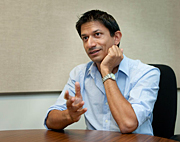- Number 320 |
- September 13, 2010
Patel recognized as Titan of fast ignition fusion

Prav Patel
Prav Patel’s parents always wanted him to become a medical doctor. He did go on to receive a doctorate, but it wasn’t exactly in medicine.
“I did get a doctorate, but it just was in something else,” said the 37-year-old who chose high-energy density physics.
It pleased his parents just the same. And now Fusion Power Associates has awarded Patel its 2010 Excellence in Fusion Engineering Award.
“I wasn’t expecting it,” said Patel who was honored for his work in relativistic laser-plasma interaction and his leadership in the development of the fast ignition concept for inertial confinement fusion (ICF).” It really represents the accomplishments of the entire fast ignition team here at Livermore.”
Patel jumped right into the field of relativistic laser-plasma interaction and fast ignition when he arrived at the Lab 11 years ago. As a postdoc, he started his work in high-intensity, short-pulse lasers at LLNL’s Jupiter Laser Facility using first the 100-terawatt Callisto laser and then the petawatt-class Titan laser.
The fast ignition concept differs slightly from the National Ignition Campaign’s scheme for achieving ICF. While in the NIC, ignition will be achieved by creating a hot spot at the center of a compressed target using the long-pulse NIF laser, fast ignition uses a similar long-pulse drive to compress the target, but then uses an ultrahigh-intensity short-pulse laser to rapidly heat a small region of fuel to ignition temperatures.
“This is an alternative method of achieving ICF,” Patel explains in a soft-spoken manner. “It has the potential for achieving higher gains than the hot spot technique.”
The physics of ultrahigh-intensity, short-pulse laser-plasma interaction is very challenging, according to Patel. It involves the combination of relativistic-intensity light pulses with extreme high-energy-density plasma states.
Integrated subscale experiments are under way on the Omega laser at the University of Rochester, and the first full-scale fast ignition compression experiments will be fielded on NIF later this year. Although high-gain fast ignition will take several more years, the idea that fusion will soon be achieved by the NIC creates a stir in Patel.
“It’s great that we’re doing it here and in the next year,” he said. “It will dramatically change the view of fusion energy. There’s tremendous interest in achieving ignition, and then you have to ask, ‘What’s next?’”
Fusion Power Associates Excellence in Fusion Engineering Award was established in 1987 in memory of MIT Prof. David J. Rose to recognize people in the relatively early part of their careers who have shown both technical accomplishment and potential to become exceptionally influential leaders in the fusion field. Patel will receive his award at the annual meeting and symposium, Dec. 1-2, in Washington, DC.
Raised in London, Patel headed to Oxford when he was 18. He spent seven years there, earning his bachelor’s degree and Ph.D. in physics before he arrived at the Lab for a two-year postdoc appointment. In 2001, he became a staff scientist.
When he’s not in the office, Patel enjoys staying fit by running, going to the gym and doing yoga. But if it’s winter time, expect to find Patel on the slopes of Lake Tahoe, Utah or even the Alps. —Anne M. Stark
Submitted by DOE's Lawrence Livermore National Laboratory
